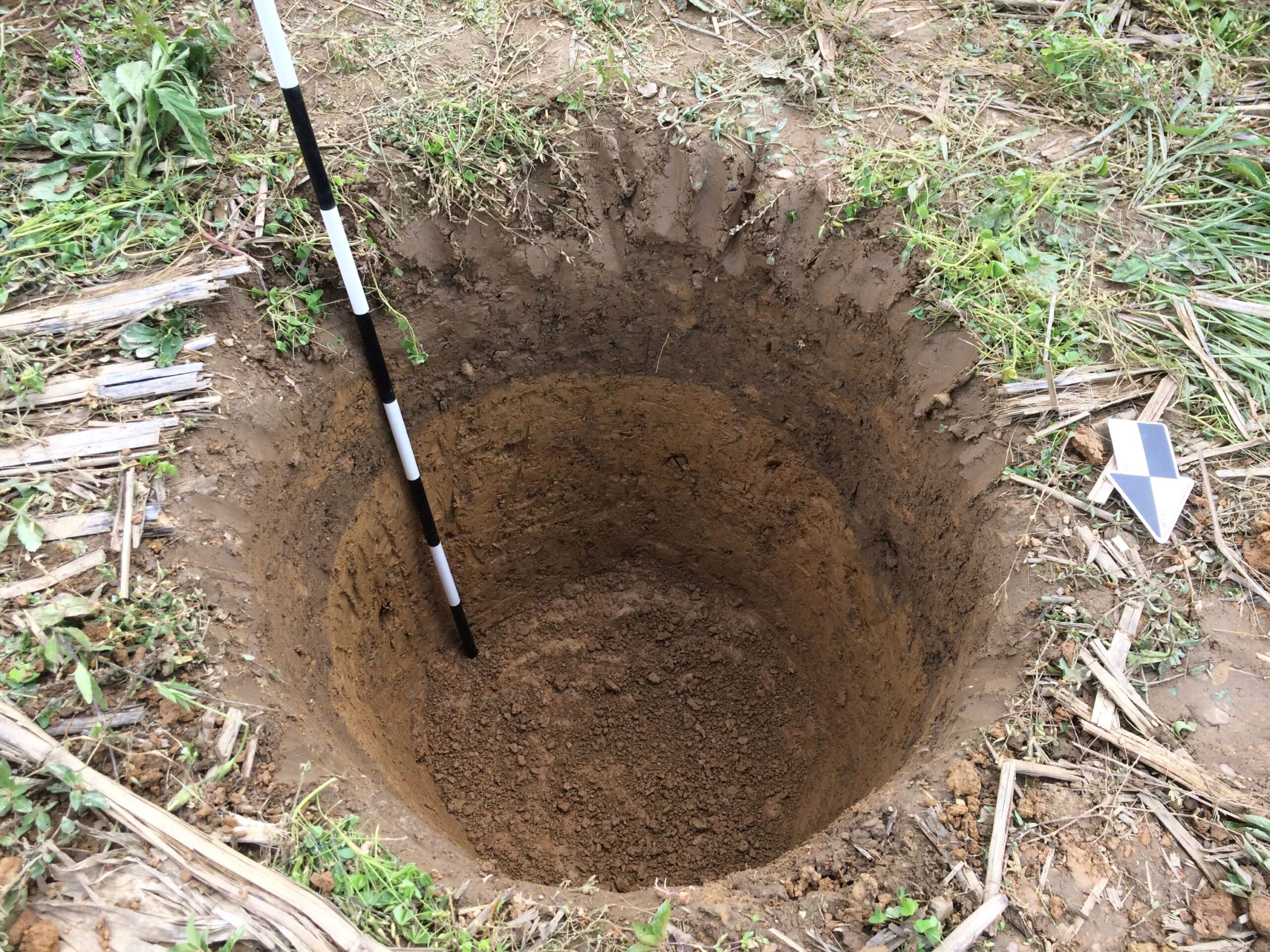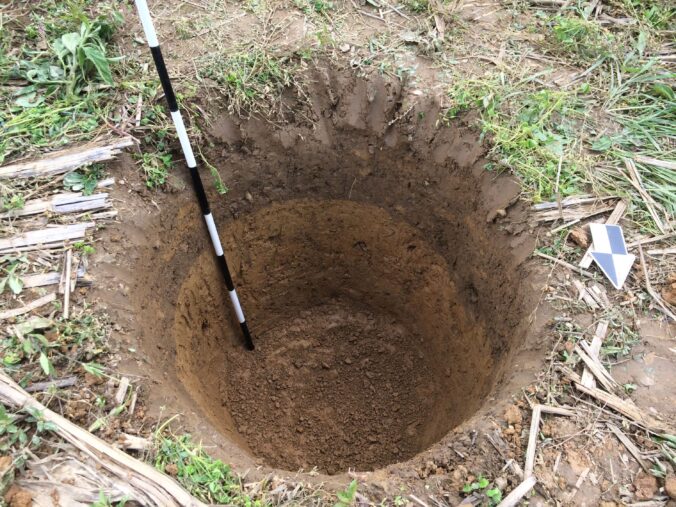October is Archaeology Month, so today let’s talk about a key part of identifying archaeological sites: geoarchaeology and geomorphology.
Understanding how the land has changed through time is an important first step in identifying archaeological sites. Natural forces bury archaeological sites. Human activity can also further bury these sites (particularly in urban areas) or destroy them altogether.
To study the changes in the land through time, archaeologists rely on geoarchaeology and geomorphology. These studies combine geology, soil science, and archaeology to help us to answer the question of how deep we need to dig to identify archaeological sites.
Knowing how deep to dig to identify archaeological sites is especially important to the Environmental Review process. My job here at the PA SHPO is to help state and federal agencies determine if their projects could impact significant archaeological sites. Often this means archaeologists need to do a survey to identify sites. If archaeologists do not dig deep enough during the archaeological survey, then archaeological sites could be destroyed by a project without even knowing they were there.
So just how deep do archaeologists need to dig? If you don’t want to read any further, the short answer is sometimes archaeologists dig about one foot deep… and other times twenty feet deep. The difference comes down to the landform that they are working on.
How deep do archaeologists need to dig in uplands?
Uplands are the hills, ridges, and other landforms of Pennsylvania up above stream and rivers. On these landforms, soil is formed primarily by the decay of bedrock and the addition of organic matter. As you can imagine, this process is not quick.
So, the things that people left behind are not buried very deep. Usually that means upland archaeological sites are within the first 12 inches beneath the surface – a bit less if the area has never been plowed and a bit more if the area has been plowed.
In upland areas of Pennsylvania that have been plowed, the soils that we find usually look like the first photo. At the top of this shovel test pit (STP) is a dark brown soil horizon, the topsoil, or an A Horizon (technically it is an Ap Horizon, since it has been plowed, but let’s stay outta the weeds). Below the Ap Horizon in this example is a yellowish-brown clay subsoil (a Bt Horizon). This mineral subsoil is a decayed bedrock that has started to go through the soil formation process.
In uplands, archaeological sites will mostly be identified within the A Horizon. There are some exceptions, because there are always exceptions, but the subsoils below the A Horizon are generally much too old to contain artifacts. These soils formed during a period when people were not yet on the continent.
Cultural features, like a fire hearth, a stone foundation, or a storage pit, may extend into the subsoil if the people who created them excavated into the subsoil themselves.

Shovel Test Pits, like this one in Indiana County, are excavated to identify archaeological sites in areas where sites are not expected to be buried very deep. This STP was dug two feet deep, but archaeological sites would have been limited to about the top 10-12 inches.
How deep do archaeologists need to dig along streams and rivers?
Everything is different along streams and rivers. Here soil can build up through time by regular flooding, where floodwaters deposit new soil onto the areas adjacent to the stream or river. As a result, thousands of years of previous ground surfaces are stacked on top of each other. Within these stacked deposits are artifacts and cultural features left behind by people. So, in contrast to uplands, archaeological sites are not limited to just the surface A horizon.
To help make sense of these complicated landforms near waterways, archaeologists rely on geomorphologists to study the soils and to determine the depths of soils with the potential for archaeological sites. Geomorphologists need to look deep beneath the surface.
One method to do this is mechanical trenching with an excavator to get a view of the soil profile. Auger borings are another method to look beneath the surface. Each method provides the geomorphologist a view of the soils, allowing them to determine where archaeological sites could be located.

Large-scale mechanical trenching using an excavator (Photo from PA SHPO Files, 2022RP00177).
Over 450 geomorphological investigations have been conducted in Pennsylvania as part of the Environmental Review process. This information has helped to identify many archaeological sites, including site 36AL0480 along the Allegheny River. This site was buried over 20 feet below the surface and was excavated in advance of a US Army Corps of Engineers dam project.

Archaeological investigations at 36AL0480 along the Allegheny River in Leetsdale (photo from PA SHPO files, 2012RP00662). The archaeologists working here are excavating a level of the site that dates to approximately 6,800 years ago.
Deeply buried archaeological sites like 36AL0480 are an extreme example though. More often, geomorphology is used to help determine the appropriate site identification methods at a much smaller scale. Along Pennsylvania’s smaller streams and rivers, archaeological sites tend to be buried up to about 3-6 feet below the surface.
If geomorphological investigations determine the soils to be less than 3 feet deep, shovel test pits (like in our very first photo) can be excavated to identify archaeological sites. But if archaeological sites could be deeper than 3 feet, larger test unit excavations are necessary.
The soil profile along Pennsylvania’s smaller waterways generally looks something like the example below from Huntingdon County. In this test unit, Native American stone tools were identified in the soil horizon below the red line. The two feet of soil above this red line was deposited after those tools were left behind. Compare this with the first photo of a shovel test pit, which had a similar Ap horizon at the surface but had very different underlying soil.

1 x 1 meter square test units, like this one in Huntingdon County, are excavated in areas where archaeological sites are anticipated to be deeper beneath the surface. In this case, artifacts were found in the lighter brown soil below the red line, with the overlying alluvial soils sealing and preserving the archaeological site.
For thousands of years people relied on the creeks, runs, streams, and rivers of Pennsylvania. The two examples above in Allegheny County and Huntingdon County illustrate how alluvial settings can be unique in preserving significant archaeological sites deep (and really deep!) beneath the surface.
Thankfully, geomorphology can help us identify these sites before they’re lost to development projects.
Geomorphology Reports in PA-SHARE
A note here at the end for professional archaeologists working in Pennsylvania.
Prior to the launch of PA-SHARE, the PA SHPO was not mapping geomorphological surveys in our database. That’s changed and the 450+ geomorphology surveys that have been completed since the 1980s are now mapped in PA-SHARE (thanks to our summer intern, Lauren Metzger). These surveys are mapped in the same layer as other archaeological surveys.
They can also all be found in the reports section of PA-SHARE by searching for “Geomorphological Report” in report type.
More!
If you’d like to read some more, we’ve touched on geomorphology and deep testing to identify archaeological sites on fluvial landforms in some other recent blog posts like Meet the Paleo-Digger and Recent Archaeology on the Upper Ohio River Floodplain.
Some additional information on 36AL0480 in Leetsdale is also available on the archived version of our website:
https://www.phmc.state.pa.us/portal/communities/archaeology/native-american/leetsdale.html
And if you still can’t get enough, geomorphologist Dr. Frank Vento discusses the geomorphology of Pennsylvania in Digging Deep: Buried Landscapes of Pennsylvania, which is available on our YouTube channel: https://youtu.be/yu-KGKWO200?si=L5GUrK6phxpnbAQY.
Justin McKeel is the Environmental Review Archaeologist for the Central Region of Pennsylvania. He misses digging holes, so he wrote this post about them instead.
Comment Policy
PHMC welcomes and encourages topic-related comments on this blog. PHMC reserves the right to remove comments that in PHMC’s discretion do not follow participation guidelines.
Commenters and Comments shall be related to the blog post topic and respectful of others who use this site.
Commenters and Comments shall not: use language that is offensive, inflammatory or provocative (this includes, but is not limited to, using profanity, obscene, or vulgar comments); disparage other commenters or people; condone illegal activity; identify the location of known or suspected archeological sites; post personal information in comments such as addresses, phone numbers, e-mail addresses or other contact details, which may relate to you or other individuals; impersonate or falsely claim to represent a person or an organization; make any commercial endorsement or promotion of any product, service or publication.
If you would like to comment on other topics not related to this blog post but related to PHMC, please fill out the PHMC Contact Us Form.

How do you know the age of a soil horizon?